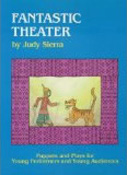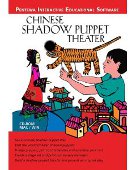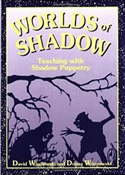
River Place Elementary
Enacting Himalayan Myths, Tales, and Legends
|
THIRD GRADEIn Texas there is a set of standards for every subject at every grade level called the Texas Essential Knowledge and Skills. For third grade Theatre, shadow puppetry is part of the curriculum. Following is a link to all of the TEKS and the third grade shadow puppet section is quoted.
Each class will be divided into groups of about four students. They will choose the play they want to do and decide who is going to make each puppet and who is to perform each character. (The teacher can predetermine this if s/he feels the need.) If all groups are doing the same story, divide them up by the part they want to play: dragon, rooster, worm, and narrator. This book is a great start as it has a simple story with three charaters and a narrator. The puppet shapes are ready to be traced or copied. White cardstock can be used as it will create a shadow for the performance. These can be traced or already run off. The book suggests the use of chopsticks to attach the characters. I like to use thin BBQ skewers. Students can color them if they wish if there is time, but if doing the shadow puppet format, the colors won't show when using paper. (See fourth grade shadow puppets.) For shadow puppet performances, I put our short puppet stage on a table and put white butcher paper over the opening. At the back, place a bright light. I like to use an overhead projector. Students can put small images on it to create larger scenery. They also can have a character when it is small behind the stage and if it is to be large ON the overhead. Some of the other books have great ideas for scenery. **************
This book is a fabulous resourse for shadow puppet plays and images to trace for puppets. It has 30 puppet plays adapted from nursery rhymes, folk songs, fables, poetry, folktales, and myths with instructional chapters on making and using rod and shadow puppets and puppet stages. Several of the plays are from Asia. Animals puppets for other plays in this book could be easily adapted for both Jataka stories and folktales of the Himalayan Region. I have three copies of it as it is popular with the students.
These are other great sources for information on making and performing with shadow puppets. *****************************
I also usually teach my third graders to sew by hand and machine by making their own hand puppets. Usually they create their own character whether it be an animal or person. This year, if there is time to sew, I will show them my snow lion puppet and give them simple ways to create their own.
|
This site was created by Diana D'Émeraude at the NEH Summer Institute "Literatures, Religions, and Arts of the Himalayan Region," held at the College of the Holy Cross, Summer 2011.


 This is software.If you can get a copy and use it on your computer, I strongly recommend this as an additional story and source. The scenery, animals, and people in this traditional story on promise-keeping are on the CD and can be sent to a printer. There is a brief animation of the story.
This is software.If you can get a copy and use it on your computer, I strongly recommend this as an additional story and source. The scenery, animals, and people in this traditional story on promise-keeping are on the CD and can be sent to a printer. There is a brief animation of the story.


